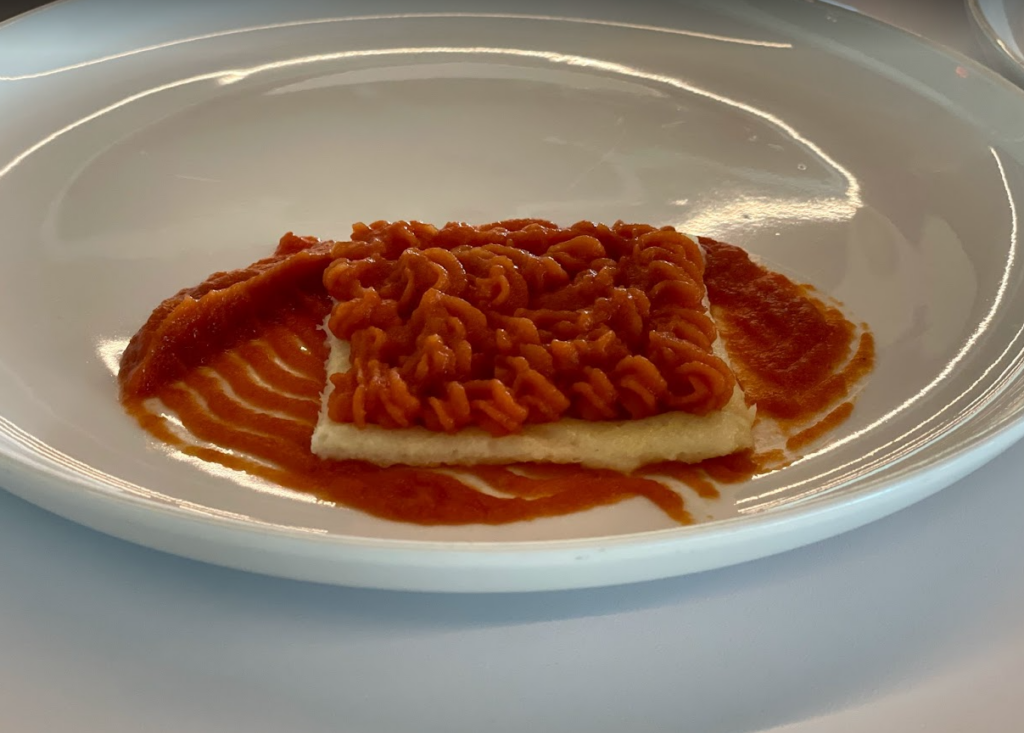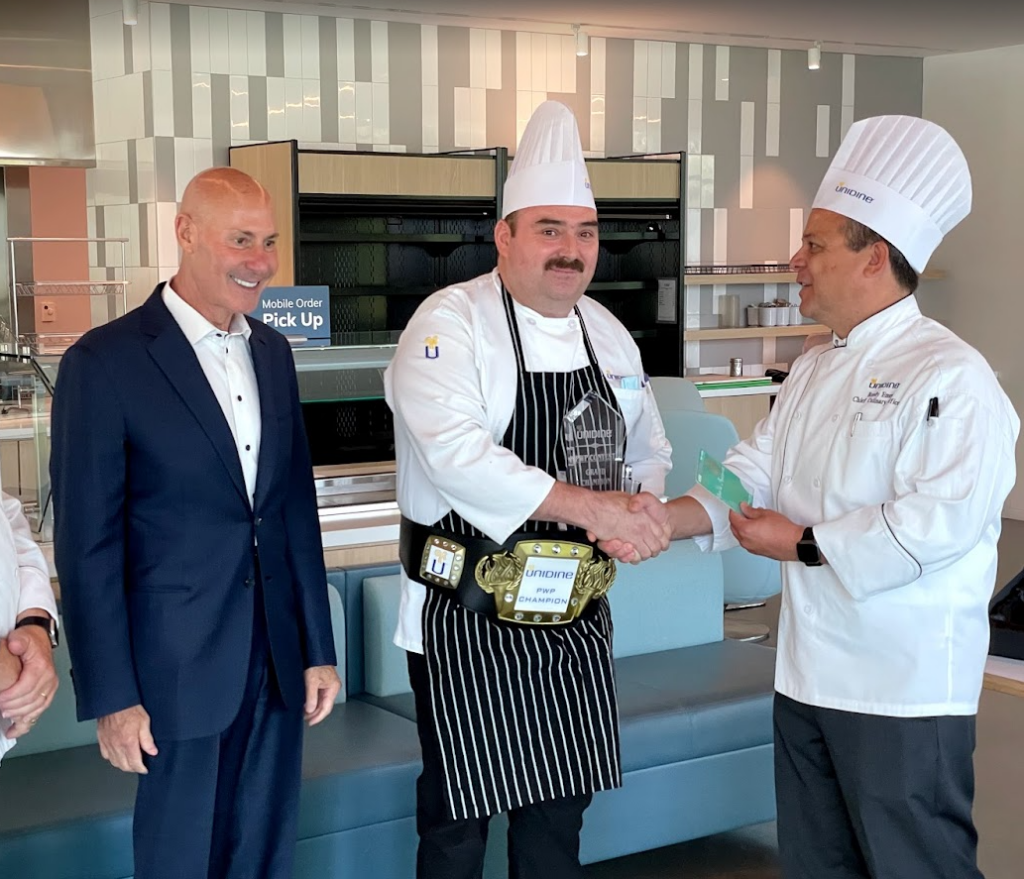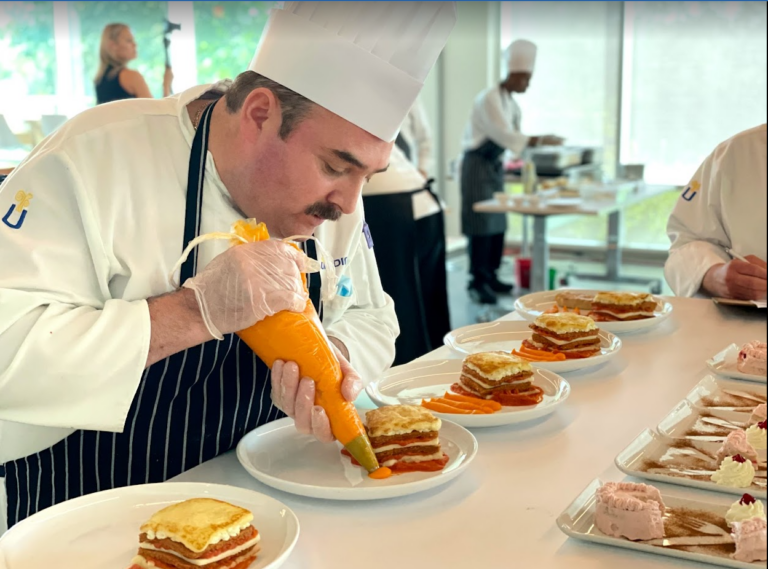
Nancy, who studied and worked in France for 10 years, writes about health, cultural events, food and the healing power of the arts.
The art of pureed food — and other food modifications — to meet special dietary needs
Eating should be a pleasure, but for some people this basic necessity becomes a chore. Local chefs are turning to more options — such as small bites and pureed foods — to make mealtime enjoyable again.
Wm. Charlie Brown, executive chef at The Moorings in Arlington Heights, mentions research that shows people with Alzheimer’s disease and other dementias often lose dexterity in their hands, rendering them unable to hold eating utensils. But Unidine Corporation — a dining management company that serves senior living communities nationwide — has found a simple solution: Chefs create hand-held, small bites that allow these residents to be independent and have the satisfaction of eating meals on their own.
Residents might enjoy a mini hamburger for protein, garnished with lettuce and tomato; meatloaf nestled in a hollowed-out cooked potato; or thinly sliced chicken in a lettuce wrap. When local asparagus is available, the tips and thin strips of the stalks fill an easy-to-hold tart shell.
“We do everything from scratch and use local, seasonal ingredients when we can,” Brown says. Herbs such as basil and thyme, grown in The Moorings community garden, add an extra burst of flavor. Mini cakes and sweet tarts are popular desserts. “We do the meal in stages with one course at a time,” Brown says.
The nutritious, hand-held items also eliminate another issue because residents can eat them on-the-go, whether in the dining room or other areas of the memory care unit where they are always supervised.
“We know that people with dementia are restless and don’t like to sit down, so they can eat while they are mobile,” Brown says. In addition, the aromas from the bread-making machine stimulate residents’ appetites and prompt them to recall memories from their own kitchens.
Some people with Alzheimer’s and other dementias also reach a stage in which chewing and swallowing food becomes difficult. Called dysphagia, this problem can result from stroke, cancer, reflux, Parkinson’s disease, or other neurological diseases. It can lead to a variety of health issues, including choking, pneumonia, malnutrition, and dehydration.
While eating standard food carries risks for some, pureed food which is safer, can often be unappetizing. Jeannine Forrest, PhD, RN, of Dementia Coach On-Call, recalls consulting at a nursing home where a woman with dementia was losing weight.
“She was sitting in front of a bowl of a dark gray blob of food which was catfish,” Forrest says. “It’s no wonder she wasn’t eating, because the food was unrecognizable and unappetizing. Food should be appealing.”
 At Lake Forest Place, Chef Juan Fernando Ortega set out to elevate the quality of pureed food. In 2021, he entered the Puree with a Purpose Challenge, hosted by Unidine. Ortega won first place in the competition. For his prize-winning main dish of lasagna, he cooked and pureed the ingredients so they would be safe to swallow and then layered them to resemble the classic Italian dish. He accompanied the main dish with baby carrots and a raspberry cream cake for dessert. Not only did the aroma, color, flavor, and nutritional value of the food remain intact, but Ortega transformed each course into a beautiful work of art and mirror image of the original dish.
At Lake Forest Place, Chef Juan Fernando Ortega set out to elevate the quality of pureed food. In 2021, he entered the Puree with a Purpose Challenge, hosted by Unidine. Ortega won first place in the competition. For his prize-winning main dish of lasagna, he cooked and pureed the ingredients so they would be safe to swallow and then layered them to resemble the classic Italian dish. He accompanied the main dish with baby carrots and a raspberry cream cake for dessert. Not only did the aroma, color, flavor, and nutritional value of the food remain intact, but Ortega transformed each course into a beautiful work of art and mirror image of the original dish.
“Don’t forget that we eat with our eyes,” says Michael Troehler, executive chef at Lake Forest Place.
Following his award-winning 2021, Ortega entered the Puree with a Purpose in 2022 with a new menu: Chateaubriand with mushroom bordelaise, rosemary parmesan polenta, red and gold beets, and carrot cake with cream cheese frosting.
While Ortega prefers to let his dishes speak for themselves, Troehler, who gave the chef a helping hand to prepare for the competitions, says the top awards were well-deserved.
“One of the first times Ortega served his pureed dishes to residents, one of them returned it to the kitchen because the presentation was so attractive that he thought it was a mistake, that it wasn’t the real meal,” Troehler says.
Troehler cautions that individuals caring for a loved one with dementia at home should not try to replicate Ortega’s pureed food dishes.
“Pureed food can have different kinds of thickness — such as honey thickness and nectar thickness — and if it’s not right for the individual, it could be dangerous because they could choke on it,” he says. “It is best that the family member become educated about the specific conditions and diagnosis of the person with dementia and then get advice from the person’s doctor and medical team about a diet.”
Forrest, who conducted a program at Lake Forest Place focusing on how to feed people with dementia, had the opportunity to taste Ortega’s pureed food dishes. “Ortega’s food is lovely to look at, and once you get used to the consistency, it is very flavorful,” she says.
She points out that the appearance of the food for people experiencing difficulty swallowing is but one of the important aspects of their meal.
“Dining should be a pleasurable experience for them,” Forrest says. “It is also about the ambience, the company around the person, how the table is set, and the flavor of the food, so that it enhances their remaining quality of life.”








